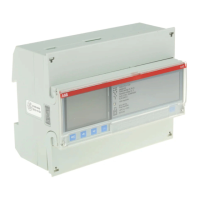Meter Settings
A43/A44 36 2CMC48001M0201
User Manual Revision: C
• Communication out (Comm.out on display)
• Pulse out (Pul.out on display)
1. This choice makes it possible to control outputs by time.
2. I/O 1 and I/O 2 are set to static output by default.I/O 3 and 4 are set to static
input by default and cannot be configured. I/O 3 and I/O 4 are not shown in
the display.
3. This choice makes it possible to control fixed I/O outputs by time and thus
only available in gold meters.
4.1.7 Setting Alarm
To set the alarm, perform the following steps:
Choose the Settings icon in the main menu, press .
The display will show what quantity shall be measured. Depending on the
meter type, different quantities are available. See table and table 4:3 for
available quantities and interval/units for the different quantities. Set the
Press once to get to the next menu. The display will show what level the
alarm will trigger on. Set the alarm level.
Press once to get to the next menu. The display will show the time that
the measured value has to be higher than the limit set in the previous step
in order for the alarm to trigger. Set the time limit.
Press once to get to the next menu.The display will show what level the
alarm will cease on.Set the alarm level.
Press once to get to the next menu. The display will show the time that
the measured value has to be lower than the limit set in the previous step in
order for the alarm to cease. Set the time limit.
Press once to get to the next menu.The display will show if the alarm
will be logged or not. The available values are “on” and “off”. Set logging
Press once to get to the next menu. The display will show what output
the alarm is set on (or if no output is set). The available choices are
dependent on meter type, see table 4:4.
Note – If choosing an I/O that is not alarm configured, the option will be set to “no
output” when pressing the button.
10.The first alarm is now fully configured. Depending on the meter type,
up to 25 alarms can be set. If your meter supports multiple alarms, use
and to set the remaining alarms the same way as the first alarm was
configured.

